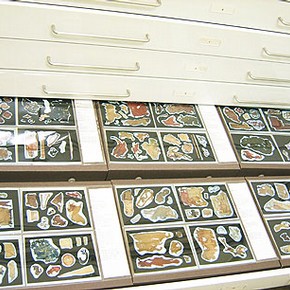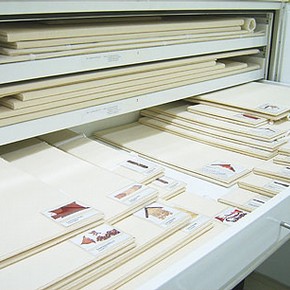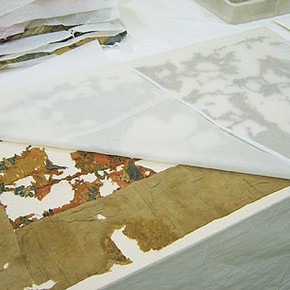Conservation Journal
Spring 2007 Issue 55
Storage of the Stein Loan Collection

Figure 1. A storage drawer housing six boxes, each containing four Plastazote® trays. (Photography by Thórdís Baldursdóttir) (click image for larger version)
A nine month project funded by The Andrew W Mellon Foundation was set up to improve the storage of the 600 objects in the V&A Stein textile collection. The objects had been stored in six drawers (1690 x 790 x 105mm) and on part of two shelves in the textile store, Far Eastern Collection Offices. A limited amount of extra space was allocated for the improvements. Some work had already been carried out as part of the project, and a large number of small flat textiles had been put in ready-made acid free card folders. Most of the other small objects were in transparent bags labelled with adhesive stickers. Various mounting techniques and conservation treatments have been used since the collection arrived at the V&A. Textiles had been sandwiched between two sheets of glass, Perspex® or glass and wood. Fragments had been adhered to card or net and stitched onto backing fabrics adhered to boards. A priority for improvement was a drawer storing 46 large flat textiles in 21 layers, making them very difficult to access. At this point almost all of the objects had already been removed from original Stein packaging (mostly envelopes and fabric bags) but a few very fragmented textiles were still kept in the original paper parcel wrappings.
The key objectives of the storage project were to:
-
preserve the archaeological textile collection, where possible as found, although some of the objects had been treated at the Museum prior to this project
-
provide safe, protective storage and remove and replace any unsuitable and potentially harmful storage and mounting materials
-
improve access for study and safe handling within the Museum
-
clearly label all objects and other material linked to the collection, to include the museum loan number, the original Stein site number and a photograph
-
list the exact location of each textile.
The very limited space available for this large number of objects meant that it was necessary to consider the entire collection as a whole and select methods to make the best use of the space. This required careful examination and measurement of each object. This showed that it would be possible to store 271 fairly small three-dimensional textiles in Plastazote® foam (ethylene copolymer) lined trays (20mm or 40mm deep). The outline of each textile was taken on a Melinex® (transparent polyester film) sheet and then transferred on to paper. Where possible, objects from the same archaeological site were kept together, but the main objective was the optimal use of the space available. The diagram of each tray was scanned and Plastazote cut on the mount-cutting and box-making machine (Zund Plotting Systems). This was attached to Correx® boards using double sided tape (Tesa-4965). Heavy-weight Melinex sheets were cut to shape and placed under each object to act as a barrier between the textiles and the textured Correx and to make handling easier. Boxes, to keep the trays in, were made to measure from archival folding box board. Photographs of each layer and object numbers are attached to the box lids to identify the textiles in each drawer without the need for handling (Figure 1).

Figure 2. Flat textiles in padded fabric-covered folders, labelled with photographs (Photography by Thórdís Baldursdóttir) (click image for larger version)
Larger three-dimensional objects, including many shoes, were placed on individual padded boards. The boards were made using a Correx base covered with Domette (a thick brushed cotton) and scoured Calico (plain woven cotton fabric). Where necessary, soft 3-D mounts were made to fit inside the objects for internal support.
It was necessary to make the best use of the depth of the drawers and find a solution that would make it possible to access and safely store large flat textiles. Most were placed in fabric-covered padded folders (Figure 2). Both sides of the folder were padded with thick Domette to support and hold the shape of the textile. For three-dimensional textiles, several layers of Domette were used to make a relief. All the folders were labelled with numbers and an image. Very large flat textiles were put on rigid, lightweight, fabric-covered boards, padded on both sides. A large fragmented silk embroidery, needing special attention because of its fragile condition and size, was placed on a lightly padded, rigid board, covered with a nylon net overlay stitched to one side of the board and attached with Velcro® (hook and loop fastening) to the other three sides (Figure 3). The fabric covered folders make it possible to store up to six layers in a drawer or on a shelf, allowing for easy access and the safe handling of both sides of the object.
A decision was made to remove and replace most of the previous mounts, which were made of inappropriate and potentially harmful materials. The old glass was heavy and difficult to handle and removing it was also in line with current health and safety practice. Some of the Perspex was heavily scratched and many of the mounts had already been partly opened to gain access to the objects for photographing. The textiles were carefully removed from their mounts and put in Melinex sleeves and/or fabric-covered or card folders. This allowed the backs to be studied, revealing interesting details.

Figure 3. A fragmented silk embroidery (LOAN:STEIN.343, Ch.00294) on a padded board with a net overlay. (Photography by Thórdís Baldursdóttir) (click image for larger version)
Special consideration was given to objects treated by Joan Joshua who worked with Stein and carried out documented treatments on the collection. It was therefore felt to be important to preserve examples of her work. The mounting technique Joan Joshua used was to adhere textiles to pure linen board using flour and water paste on thin strips of Japanese paper.1 A few of these textiles were removed from the boards based on their condition and, in some cases, to gain access to the reverse. Textiles on boards were put into new folders and labelled with both object numbers and a photograph. Seven very fragmented textiles, still in original Stein paper parcels, were kept in their wrapping but given further support in new boxes or folders. Other original packing materials such as envelopes, fabric bags and paper wrappings are housed in folders together with corresponding objects. Alternatively, they were kept in a box, labelled and placed in Melinex sleeves for safe handling. A list was completed, stating the exact location of every object in the store.
The storage of and access to the collection has been improved considerably. The clear unified labelling enables objects to be easily located. Unsuitable storage and mounting materials have been replaced. The preventive nature of the new mounts and storage methods supports the shape and condition of the textiles and encourages careful handling without the need to touch the fragile objects. These improvements will hopefully result in further study and research into this important and diverse collection of Asian textiles.
Acknowledgements
I would like to thank Chris Gingell, Preservation Conservator, for his help and advice and Yueh-Siang Chang, Assistant Curator, Asian Department, for her assistance.
Reference
1. Godden Amos, A., 'The Stein Loan of textiles in the Victoria and Albert Museum', V&A Conservation Journal , no 26 (January 1998), pp.8-10
2. Joshua, J., 'The Restoring of Ancient Textiles', Embroidery ( September 1933), pp.15-18
Spring 2007 Issue 55
- Editorial Comment - Conservation Journal 55
- Stein Mellon Textile Project at the V&A
- Storage of the Stein Loan Collection
- Discoveries on a pair of cassoni
- Treatment of two Coptic tapestry fragments
- Surreal semi-synthetics
- Investigation of the patina on Bidri using advanced surface analysis techniques
- Printer friendly version